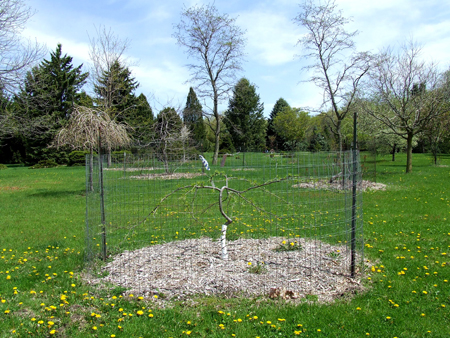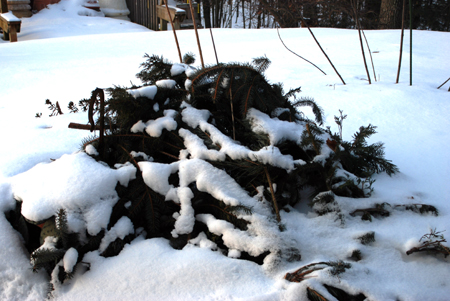Winter protection: Just one of many fall garden chores
It’s time to get you garden ready for ‘ol man winter whether you like it or not. Keeping the rodents and deer away, creating protective barriers and digging up tender perennials are things to consider now.
In this neck of the woods, gardeners are often plagued with rabbits, squirrels and deer who hungrily feed on bark and buds of prized plants. I think that sometimes squirrels just chew on bark to be malicious and wear off energy. Either way, it is troublesome.
One way to protect your plants is to create a barrier by using a mesh screen or plastic tree wrap. Simply wrap the screen around the potentially affected areas and secure into place with a few garden stakes and bread ties. Commercial tree wraps are available as a “coil” that you twist around the trunk until secure. All wraps should have air holes so as not to trap unwanted moisture along the trunks and they should be removed next spring.
Repellants will work for many animals including deer, but the trick is to keep applying it after a significant amount of rain or snow. The times when I have had the most damage from deer at home was when I forgot to reapply. For more information on repelling dear during the winter, read “Oh, deer. Oh, dear” by MSU Extension’s Beth Clawson.

Protect shrubs and small trees from deer browsing by using
chicken wire fencing and wrap them to prevent rodent damage.
Keep them shady
If you have broad leaved evergreens such as Rhododendron that receive full sun in winter, this is a good time to think about creating a shade barrier. A few plant stakes on the south and west side of the plants with burlap attached the height of the stake should provide adequate protection from both wind and sun.
If you don’t want to look at ugly burlap all winter, you may want to think about other ways to create shade. I usually cut my spent Christmas tree limbs and create a teepee effect by arranging them around the plants. Either way, it helps keep the desiccating sun off those shiny green leaves. Plant protectant sprays can also help conserve moisture in the leaves and some growers swear by them.

Shade and wind protection can be provided for Rhododendrons or other sensitive
shrubs by re-cycling your holiday tree boughs in a teepee around them.
When in doubt, lift them out!
Tender perennials such as Canna also need to be lifted before the ground freezes. I prefer to “harvest” tender perennials just after a light frost, which hastens the dormancy of the tuber, corm or bulb.
Lifting them is easy. Simply use a spade and dig the whole plant out. You can shake off excess soil and let them dry down for a few days in your garage or under a porch where they won’t get wet by rainfall. Simply cut off the excess foliage and place them in a cool, dark environment that does not freeze (I often used a labeled paper grocery bag). Every month or so, check them for withering or rotting. I find that each Canna variety over-winters with a different success rate.
Next March, haul them out and shake off the old soil, then pot and place in a sunny window to get a jump on growth next spring. Any tender perennial when left too long will freeze or rot. Don’t underestimate the weather – when in doubt, lift them out!
Find out about other educational resources and classes at www.migarden.msu.edu and at Finneran’s blog. You can contact the MSU Master Gardener Lawn and Garden Hotline at 888-678-3464 with your questions.



 Print
Print Email
Email


